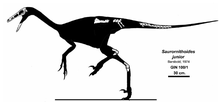Zanabazar junior
|
Zanabazar Temporal range: Late Cretaceous, 70 Ma |
|
|---|---|
 |
|
| Skeletal restoration by Jaime Headden | |
| Scientific classification | |
| Kingdom: | Animalia |
| Phylum: | Chordata |
| Class: | Reptilia |
| Clade: | Dinosauria |
| Order: | Saurischia |
| Suborder: | Theropoda |
| Family: | †Troodontidae |
| Genus: |
†Zanabazar Norell et al., 2009 |
| Species: | †Z. junior |
| Binomial name | |
|
Zanabazar junior (Barsbold, 1974) |
|
| Synonyms | |
|
Saurornithoides junior Barsbold, 1974 |
|
Saurornithoides junior Barsbold, 1974
Zanabazar is an extinct genus of troodontid theropod dinosaur from the Late Cretaceous of Mongolia. The genus was originally named by Rinchen Barsbold as a species of Saurornithoides, S. junior. In 2009 it was reclassified as its own genus, named after the first spiritual figurehead of Tibetan buddhism, Zanabazar. The holotype, GIN 100–1, includes a skull, vertebrae, and right hindlimb. Zanabazar was one of the most derived troodontids, and the second largest after Troodon.
Zanabazar is the largest known Asian troodontid, with a skull length of 272 millimetres (10.7 in). The only other troodontids that appear to be larger than it are specimens from Alaska that are currently classified in the genus Troodon.
In 1974, Rinchen Barsbold described a new specimen of derived theropod from the Bugeen Tsav of the Nemegt Formation, which is dated to about 70 million years ago. This specimen, GI No. SPS 100–1, was named by Barsbold as a new species of Saurornithoides, S. junior. The skeleton includes a nearly complete skull and braincase, part of the pelvis, some tail vertebrae, most of the right hindlimb. In 2009 a review of the genus found that the support for S. junior in the same genus as S. mongoliensis was lacking. Mark Norell and colleagues re-classified the species in the new genus Zanabazar, which they named in honor of Zanabazar, the first spiritual head (Bogd Gegen) of Tibetan Buddhism in Outer Mongolia.
...
Wikipedia
